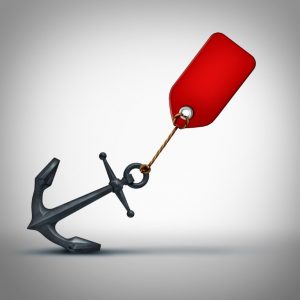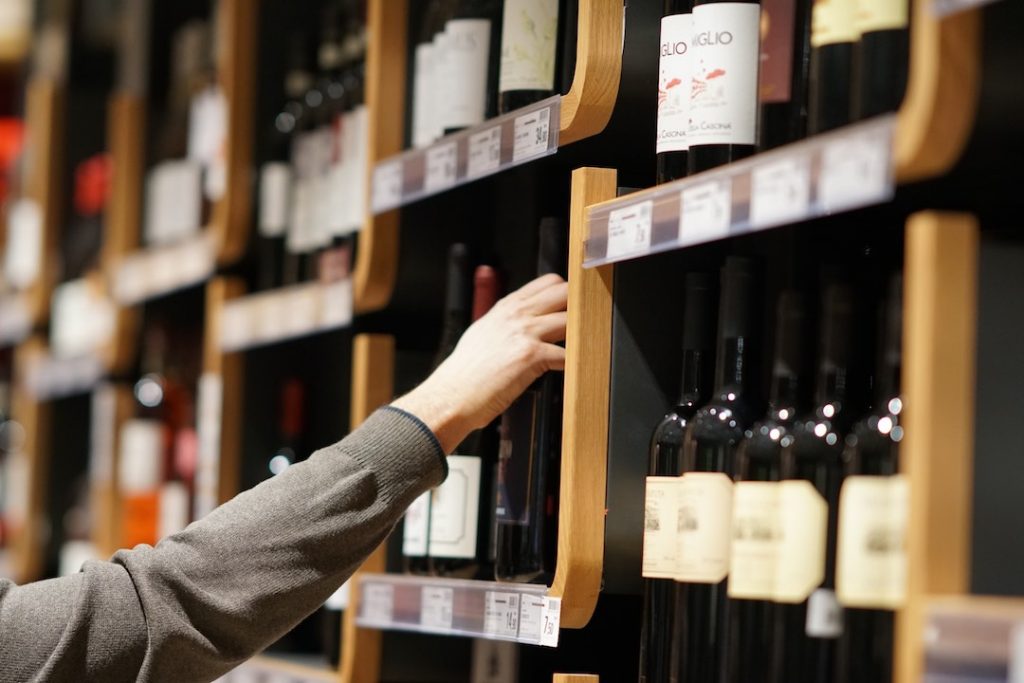 The first price your customers hear or see is the price from which they will reference all future pricing messages. In other words, the first price is the anchor that they will keep coming back to in their minds when considering higher or lower prices for the same item. Because of this psychological reality, successful consumer brand builders are very careful about setting their pricing.
The first price your customers hear or see is the price from which they will reference all future pricing messages. In other words, the first price is the anchor that they will keep coming back to in their minds when considering higher or lower prices for the same item. Because of this psychological reality, successful consumer brand builders are very careful about setting their pricing.
They know that once customers become aware of the price, it’s almost impossible to un-ring that bell. In fact, the original pricing set by the producer is almost always a higher price to give them room to maneuver with temporary price reductions and specials. In the customer’s mind, a lower price becomes compelling because the customer knows the original price.
First-Timer First Price Mistake
When we started Barefoot Wines we were pretty naïve. Our first major chain buyer asked us for our best price. We were so thrilled to get into a major chain with hundreds of outlets that we gave it to him! As soon as he had the best price, he came back and said we would have to do temporary price reductions on top of that or else we would not get display activity (the best way to attract new customers in a retail store). We were stumped. We had no more money to give. But we salvaged the situation somewhat by setting the volume to get that price at a full truckload (22 pallets) at a time. This helped our cash flow immeasurably.
That’s why as much as your buyers will demand the lowest possible price right off the bat, you must give them a price that’s high enough to allow you the opportunity for periodic temporary price reductions also known as category management or as “programming.” Without programming, your price will become stagnant. You will be unable to gain attention with special pricing or sale pricing if you offer your best price right off the bat.
Value-Based Pricing
One of our biggest challenges building the Barefoot brand was trying to give the market a good deal. Here we had award-winning wine for $5.99. We were at the velocity price point with more metals than any of our price point competition. Seemed like a slam dunk. But buyers and customers alike were comparing us to other wines at our price point – with few or no awards.
What we found out about value-based pricing is that it is difficult to get over customer perceptions based on price alone. For many, their belief was nothing good could come in a $5.99 bottle of wine. In our early days, when we were still trying to convince gatekeepers that the market would discover our value, we actually had many advisers, and more than a few buyers, suggesting that we raise our prices to communicate the value we were offering. We did not and the rest is history. But it took almost 4 years for consumers to discover our value-based pricing.
Car manufacturers have known about price anchoring for decades. Almost no cars sell for the manufacturer’s suggested retail price printed on the window sticker. It’s just a price anchor to give the salespeople room to negotiate. The same thing is true with most retail products.
Velocity Price Points
Some forms of price anchoring are created by the market itself. Such is the case with velocity price points. In every category, there is a price at which products sell the fastest. These are not always the lowest prices but they are the prices that the majority of the customers are willing to pay for items in that category. So the velocity price point itself becomes an anchor from which prices on items above that point and below that point are judged by the customer as to value, economy, or luxury.
Retailer-Dictated Pricing
Another form of price anchoring occurs when the largest retailer in the market prices an item low and in effect, dictates the prices other retailers must charge to be competitive for the same item.
When we started Barefoot Wines, the chains wouldn’t touch us because we were an unknown entity and had no budget for advertising. They wanted us to be a household word before they would allow us into their stores. We were forced to sell our products to independently owned, small, single-location stores.
But a funny thing happened which was, surprisingly, to our advantage. The first question they asked was, “Is this in the chains? Because if it is, I don’t want it!” When we said, “No, it’s not in the chains,” we were golden. Why? Because the independents wouldn’t be forced to sell our products as low as they would be in the chains. Chains buy in quantity and use the volume discounts to underprice the independents.

This is another example of price anchoring. Fortunately for us, the independents all priced our products higher than they would’ve been in the chains – because they could. So when the day came that Barefoot Wine was a household word in a chain’s territory, the higher price anchoring effect worked to our advantage. The chains could offer it for less and have more attractive pricing. And yes, the independents had to lower their prices to compete with the chains but by then they already had a base of return customers buying this proven hot mover.
Big Prices vs. High Prices
When we were selling Barefoot in New Jersey, we approached an independent retailer who had big butcher paper signs that covered his entire display window top to bottom. On that butcher paper was written in big black numbers that stood 6 feet high, “$3.99” – nothing else, just a huge “$3.99”!
When we entered the store and asked the buyer, “What’s up with the big ‘$3.99’ in the window?” He said, “You’ve got to qualify the customer! Everybody has $3.99 in their jeans. It attracts them to my store. They think it’s a sale price!” “But,” we countered, “it doesn’t even say what’s for sale for $3.99,” to which he replied, “It doesn’t matter, once they see that price they are mine!”
As we were shaking our heads in disbelief, we looked around the store. It was packed! Not only that, but everywhere in the store, sticking out of every box of products was a stick that went straight up in the air. On top of each was big white placard with more big black numbers on it. Some said “$8.99.” Some said “$5.99” or “$12.99”, and so on. The signs varied in size and in altitude. So, when you walked into the store, you were hit by a sea of prices.
“What’s up with the big prices?” we asked. “That’s right!” he quipped, “They’re big prices, not high prices.“ He went on, “Ya see, the customer thinks the bigger the price the more it’s on sale.” Then he pointed to a particular stack of merchandise. “Ya see those items over there with the big $8.99 price? Well, I couldn’t move it with a smaller sign at $5.99, and now I can’t keep it on the floor!”
When it comes to pricing, does size matter?
Apparently. This was a radically different approach than price anchoring. But like price anchoring, it was still based on the customer’s perception. Rather than comparing a sale price to a regular price, the customer was comparing the size of the sign and the size of the actual numbering of the price to others with smaller numbers! Wow!
Price Anchoring in the Digital Market
One of the biggest challenges that new consumer brand builders face is in digital marketing. It doesn’t take long for the lowest price on your product to get around to consumers. And boom! You have a new anchor price! In fact, online sales are a race to the bottom price-wise. New consumer brand builders are tempted to sell direct to the consumer because they want to cut out the middleman, don’t want the headache of the distribution system, or just plain can’t get into bricks and mortar retail stores. Whatever their reason, they face a form of price anchoring that can sink their ship.
Once you post your best price online, any further accommodations you have to make in your FOB to accommodate brokers, retailers, or distributors, is going to come directly out of your profits. So, some products that are sold direct to consumer online have to remain exclusively online because they have anchored their price so low that no retailer or wholesaler will touch them.
Anticipate Success in Your Online Pricing
This means that they will be unable to grow their brand through notion buys in bricks and mortar retail stores. This means that they will not be able to receive the big check for the big quantity that will enable them the efficiencies of scale they need to reduce their costs and increase their profits. And this means that their item won’t be distributed in 300 stores throughout the state or a region, the fastest way to grow a CPG brand.
This is why we recommend that CPG brand producers price their direct to consumer products high enough to allow for distributors and retailers. Because if they are successful with direct to consumer sales, retailers will want to carry their products. We think they should anticipate success by leaving room for the middlemen of the future.
Considerations to Make to Avoid Unintended Price Anchoring
Sometimes you can be victimized by unintended price anchoring. This can happen easily when you have not thoroughly researched what everybody wants between your warehouse and your ultimate customer. You must take into consideration any taxes or shipping, the distributors’ percentage, and the retailers’ percentage.
It’s also important to know how much your distributors will cooperate with you in a price reduction as well as how much the retailers will trim their margins to achieve the sale price. This is a very tricky business and one of the biggest challenges CPG brand builders face. One mistake and the retailer, especially the chain retailer, will price your product lower than their competition and wreck your price by lowering the anchor price.
Because of the price anchoring effect, we advise our clients to always state the full price on the invoice and then give a temporary price reduction on a separate line. On the invoice, never show the lower price as the line item, even though your buyer is paying a lower price after the reduction. The reason is simple and again, has to do with price anchoring. Once your buyers see a lower price on your items, they believe that’s their price forever! Once you go back to your original price they will be quick to complain, “Hey! I paid less last time. What did you do, raise your prices?”
Keeping the Price Intact on Sales Offers
Some marketers are so sensitive about pricing they use a fixed price as an anchor. Instead of doing temporary price reductions, they like to offer customers additional quantity for the same price. This strategy usually translates to “Buy three – get one free!” Or, “2 for the price of 1!” These gambits keep the original price intact, but still provide a compelling reason to make the purchase.
Retailers, Distributors & Pricing
One thing we learned selling to retailers both directly and indirectly through distributors, is that they will reach for the lowest price that ends in $.99 even if it means taking a hit on their established margins. They know that if they hit that price point they will see more sales than in prices that end in any other number. After a while, we would experiment with pricing to see where it would wind up considering this tactic.
Sometimes retailers would reach for a higher price that gave them a larger margin but still hit the magical $.99. Sometimes they would do just the opposite and eat the difference. The trick was to have FOB pricing that not only didn’t leave any money on the table they could pocket reaching for the higher price point, but at the same time, have a price that would not allow them to break your established prices in the broader marketplace. This was the only way we found where we could somewhat control the retail price of our product.
Pricing is one of the largest challenges for CPG brand builders. Anchor pricing is essential to provide comparison to your sale price. The more people between you and your customer with their hands out, the harder it is to establish and, more importantly, maintain your ideal anchor price. Even if you solve the equation, you must remain constantly vigilant to protect your prices. Retailers compete with each other and use your price as an expendable pawn in a never-ending chess game to attract the customer to their store. Don’t let them checkmate your anchor price!

